The ASRock Z490 Taichi Motherboard Review: Punching LGA1200 Into Life
by Gavin Bonshor on May 27, 2020 9:00 AM ESTGaming Performance
For Z490 we are running using Windows 10 64-bit with the 1909 update.
Grand Theft Auto V
The highly anticipated iteration of the Grand Theft Auto franchise hit the shelves on April 14th 2015, with both AMD and NVIDIA in tow to help optimize the title. GTA doesn’t provide graphical presets, but opens up the options to users and extends the boundaries by pushing even the hardest systems to the limit using Rockstar’s Advanced Game Engine under DirectX 11. Whether the user is flying high in the mountains with long draw distances or dealing with assorted trash in the city, when cranked up to maximum it creates stunning visuals but hard work for both the CPU and the GPU.
For our test we have scripted a version of the in-game benchmark. The in-game benchmark consists of five scenarios: four short panning shots with varying lighting and weather effects, and a fifth action sequence that lasts around 90 seconds. We use only the final part of the benchmark, which combines a flight scene in a jet followed by an inner city drive-by through several intersections followed by ramming a tanker that explodes, causing other cars to explode as well. This is a mix of distance rendering followed by a detailed near-rendering action sequence, and the title thankfully spits out frame time data.
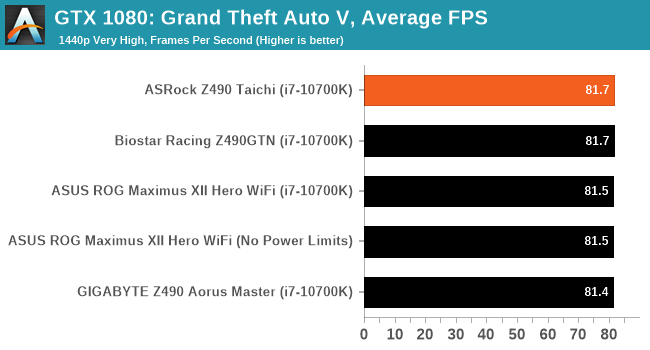
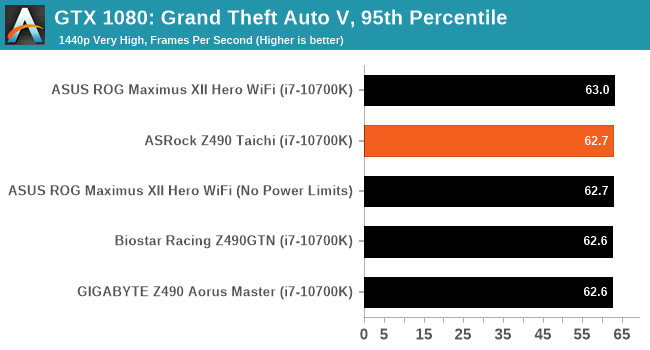
F1 2018
Aside from keeping up-to-date on the Formula One world, F1 2017 added HDR support, which F1 2018 has maintained; otherwise, we should see any newer versions of Codemasters' EGO engine find its way into F1. Graphically demanding in its own right, F1 2018 keeps a useful racing-type graphics workload in our benchmarks.
Aside from keeping up-to-date on the Formula One world, F1 2017 added HDR support, which F1 2018 has maintained. We use the in-game benchmark, set to run on the Montreal track in the wet, driving as Lewis Hamilton from last place on the grid. Data is taken over a one-lap race.
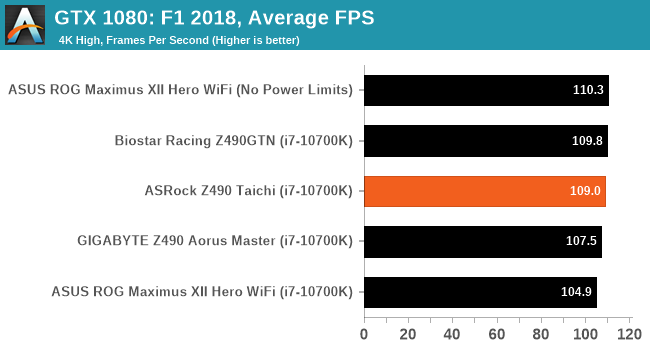
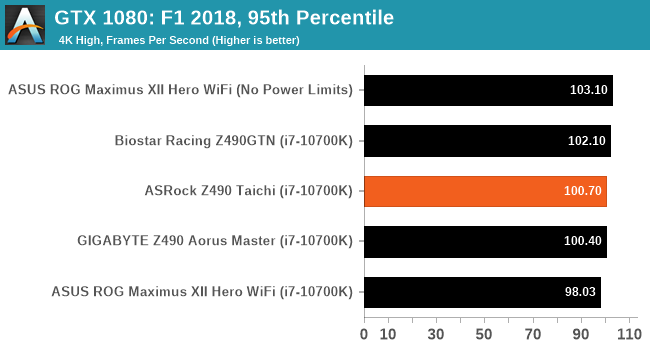
Strange Brigade (DX12)
Strange Brigade is based in 1903’s Egypt and follows a story which is very similar to that of the Mummy film franchise. This particular third-person shooter is developed by Rebellion Developments which is more widely known for games such as the Sniper Elite and Alien vs Predator series. The game follows the hunt for Seteki the Witch Queen who has arose once again and the only ‘troop’ who can ultimately stop her. Gameplay is cooperative centric with a wide variety of different levels and many puzzles which need solving by the British colonial Secret Service agents sent to put an end to her reign of barbaric and brutality.
The game supports both the DirectX 12 and Vulkan APIs and houses its own built-in benchmark which offers various options up for customization including textures, anti-aliasing, reflections, draw distance and even allows users to enable or disable motion blur, ambient occlusion and tessellation among others. AMD has boasted previously that Strange Brigade is part of its Vulkan API implementation offering scalability for AMD multi-graphics card configurations.

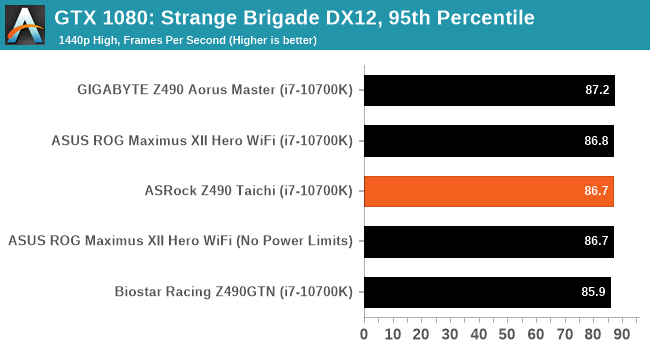













57 Comments
View All Comments
lmcd - Wednesday, May 27, 2020 - link
Honestly this is the most inane post I've ever read. Times haven't changed for the better, Raven Ridge support took over a year after the SoC was released. I own two Raven Ridge devices. I would know.Even when AMD support hits mainline, it's in such a late kernel version that you better hope this "sane" distro you're referring to is willing to backport support in an update.
Dunno what you mean about the Nvidia driver being painless to use. Its Wayland support is still comparatively unstable in Gnome and pushes KDE Wayland support from mediocre to bad. It also requires extra build tools.
I can't edit posts but I explained a key usage of nested Hyper-V. "Anyone who wants to use the Windows 10X emulator needs it unfortunately." There's also plenty of other features that use Hyper-V these days from WSL2 to Windows Sandbox, so the antiquated views on Hyper-V are also quite dated. Times have changed for the better, and Hyper-V is very much part of the present.
Congrats on your condescension though! It almost masks how wrong you are.
Dug - Wednesday, May 27, 2020 - link
Why in the world do you insist on benchmarking Non-UEFI POST Time when no one will use that?TheinsanegamerN - Thursday, May 28, 2020 - link
Because not everyone is you and there are those of us that DO use it. Wow, what an amazing thought.Dorkaman - Thursday, May 28, 2020 - link
I would love to see UEFI post time AND Windpows clean knstall boot time. My old Asus Rampage V Extreme was very slow (40s post+boot no mem test hybrid) and the new Asus ROG Maximus XII Extreme is also very slow.My Gigabyte Z390 Aorus Master posts+boots in 10+5 seconds.
Dug - Wednesday, June 3, 2020 - link
Why would you be buying new equipment for outdated OS's that aren't supported?If that's the case, the boot time is irrelevant, and my post still stands. Why even bother benchmarking it?
Ranger1065 - Wednesday, May 27, 2020 - link
A good read, always a pleasure to peruse Anandtech. The aesthetics are not for everyone but personally I think it's a nice looking board. Out of my price range but Z490 is not for me anyway. As to Asus boards, I have an older Z97 Maximus Hero VII and a Z390 Prime. Both great boards that have given me no significant issues.Jorgp2 - Wednesday, May 27, 2020 - link
Do the new CPUs have an additional 4x lanes from the CPU?I keep seeing boards that advertise 8,8,4 slots, with all of them coming from the CPU. And this motherboard for example that has the 4x gen 4 M.2, when the chipset does not have Gen 4
MDD1963 - Wednesday, May 27, 2020 - link
The specs I read said the top GPU slot would be capable of PCI-e 4.0 x16, ...and one of the M.2 slots...( perhaps I missed where it said all 4 might be capable fo PCI-e 4.0 x4 operation?_)Even with the aforementioned limits, more than enough for 99% of most folks....
Spunjji - Thursday, May 28, 2020 - link
Waiting to see how many people show up to the comments to wail about the tiny fans. After all, it wasn't anti-AMD sentiment that caused so many folks to show to all of the articles related to X570 boards (and a few that weren't) and do that, it was totally neutral concerns about longevity and noise.(Full disclosure - I am fully on-board with not wanting tiny fans on a motherboard... just feeling a little amused by the asymmetry of this. The only comment here so far on this topic has been a sensible one, not hysterical ranting.)
TheinsanegamerN - Thursday, May 28, 2020 - link
So you smugly, disingenuously re-categorize the arguments of others and think you're...clever? Funny? Intelligent?Now, here's points for asrock that might blow your mind, these are STANDARD FANS. You can go buy brand new noctuas to replace these and silence them while maintaining cooling performance. Guess what you couldnt do with x570 chipset fans? These fans also dont spin 24/7, only when needed, and the VRMs here get a LOT hotter then the x570 chipset did.
If X570 got into the 90C range without the active cooling (it doesnt) and they used standard 40mm fans (they dont) then the complaints would be baseless. But we saw how necessary those x570 fans really were. And oh hey, there are plenty of Z490 mtoherboards that dont use VRM fans! Just like that whole 1 X570 motherboard that cost like $700!